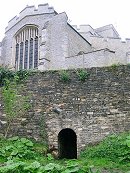Stevington
Timeline
Places > Stevington
 1279: The earliest mention of a cross at Stevington is in the Hundred Roll of 1279. The
design of the present Stevington Cross indicates it is of 13th century origin.
The base and steps were repaired in 1888.
1279: The earliest mention of a cross at Stevington is in the Hundred Roll of 1279. The
design of the present Stevington Cross indicates it is of 13th century origin.
The base and steps were repaired in 1888.
1300: The oldest part of the Church of St. Mary is the west tower. The original church was rebuilt and enlarged in the 14th century when the side chapels, now in ruins, alongside the chapel were added. In the 15th century the top stage of the tower was rebuilt and the present roof added to the nave. Beneath the east wall of the graveyard is the Holy Well which it is claimed was the place of visitation by pilgrims seeking a cure for various ailments by bathing their eyes in its water. The well has never been known to dry or freeze.
1720: Baptist Chapel built. The chapel houses an 'Act of Parliament Clock' so called as it is named after a 1797 Act of Parliament. This Act introduced a government tax on all clocks and watches making them very expensive causing people to rely more and more on clocks in public places. The chapel was renovated in 1921.
c1770: Stevington Post Mill built.
1776: Thomas Orlebar Marsh was Vicar of Stevington from 1776 until his death in 1831. He was a local antiquarian; some of his papers have been deposited at the British Library.
1805: Stevington Enclosure Act.
1863: Primitive Baptist Chapel built, it was enlarged and re-seated in 1906.
1864: The village school opened. On the 29th February the headmaster reported in the school log book that "the school opened today. Weather unfavourable. Majority of the parents attended with their children. Only about twelve capable of writing on slates." The average attendance in the first week was 62.
1871-72: Major restoration work undertaken on the church. The architect was John Usher of Bedford and the Duke of Bedford agreed to pay 1200 towards the cost. New roofs were made for the aisles and chancel, the nave was repaired, the body of the church was re-seated with deal pews and new chancel stalls and sanctuary fittings provided.
1898: The Church Room opened on the 26th April, it was built at a cost of 700. This building is now the Village Community Shop.
1921: Stevington Post Mill totally rebuilt, the rebuilding was necessary after part of the frame had collapsed in 1919 while the mill was working.
1923: Stevington War Memorial unveiled.
1939-45: On the 6th December 1940 29 evacuees with two teachers arrived from Newhaven, South Lane School.
1943: Stevington Women's Institute formed.
1951: Bedfordshire County Council purchased Stevington Windmill and restored it as part of their contribution to the Festival of Britain. The mill was last used commercially in 1936.
1957: Primitive Baptist Chapel closes, it was taken over by Robert Shaftoe as a workshop for his organ building business.
1966: A meteorite falls in a farmer's field after a heavy storm.
1974: Village Hall built.
1980s: Dovecote demolished.
1983: Stevington Lower School closes on the 22nd July, the building is now a private house.
Sources:
- Newspaper articles in The Local Studies Library at Bedford Central Library.
- Victoria County History of Bedfordshire 3 Vols. 1912.
- PICKFORD, Christopher Bedfordshire Churches in the 19th Century Vol.79 Bedfordshire Historical Record Society. 2000.
- STEVINGTON HISTORICAL TRUST Stevington : the village history. 2001.
Page last updated: 4th February 2014
